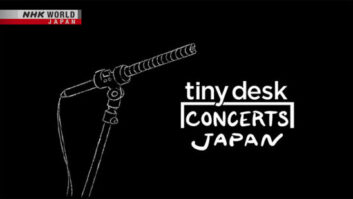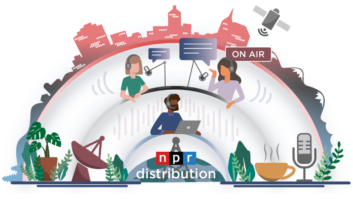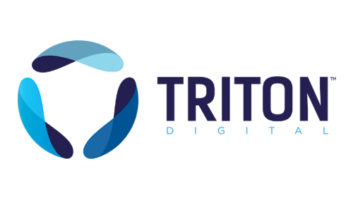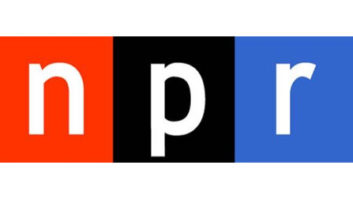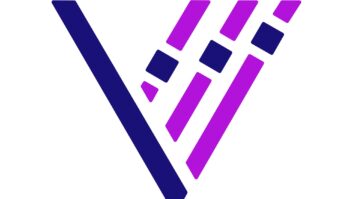The author is a data and search strategist at NPR.

Jane Gilvin
Photo by Wanyu Zhang/NPR
We continue our special series about preserving the history of radio, in conjunction with the Library of Congress’ Radio Preservation Task Force (http://radiopreservation.org).
NPR has always valued archives and research. We have an expertly organized audio archive that stretches back to the beginning of “All Things Considered” in 1971.
The early tapes reside at University of Maryland’s Mass Media & Culture collection and the Library of Congress. CDs of later broadcasts live at NPR’s headquarters in Washington, and digital files live on NPR-maintained servers. The library, the precursor to the current Research, Archives & Data Strategy team, was established very early in NPR’s history.
NPR had, until recently, never established an in-house corporate archive of historical items. If items were saved, they were saved by the creators or the people who were last in possession of them. Some individuals had donated items to UMD, but NPR’s formal relationship to paper archives did not start until roughly 1990. It’s unknown how many items were lost as employees left or as the organization moved buildings.
In 2012, NPR was planning a move to a new building. The RAD team spent years planning how to move the existing audio archive to the new building and to UMD. Management began to ask employees to clean out their work areas and purge documents before moving. The office of general counsel developed a new document retention policy, with fairly strict guidelines for what should be thrown out, and its first drafts did not include dispensation for historical items and papers.

Archival material at NPR.
OPPORTUNITY ARISES
As a team of archivists, data strategists and information managers, the RAD team felt this was an opportunity. Many items that would help document NPR’s unique position in the media could be saved, organized and preserved, instead of thrown out.
The RAD team, after reaching out and lobbying the OGC, felt we were mandated to create the historical archive. The archive would establish an internal repository for items that illustrate what NPR is, what NPR has done and who makes up NPR. Because of our relationship with UMD, we hoped to be able to work with them to preserve many of these items, but we knew items that were highly sensitive, confidential, still in use or of high value would need a home in the new building.
We certainly had several challenges: how to educate our colleagues, racing against the move timeline, securing space, physically collecting, preserving and moving items.
First, we had to educate our colleagues on what constitutes an archival record. We used NARA guidelines (www.archives.gov/about/info/whats-a-record.html) as a starting point to explain what we were looking to save.
We discussed what is of value both historically and financially. Did an item tell the unique story of NPR? What everyday item might be considered valuable in the future?
No one department in an organization of NPR’s size could accomplish a project of this size by itself. For help, we looked for allies within the organization who supported our mission, or who had already been keeping their own archives.
We found allies in unexpected places. People entrusted us with confidential or sensitive information they had previously kept secret. We moved an entire 24-box collection from the engineering department that described its history, function and importance. Our allies also donated a 14-box collection of photos, including copies of one of the photos used to celebrate Carl Kasell’s last show with “Wait Wait…Don’t Tell Me!” (https://tinyurl.com/nx75wk8).
As things were donated, we reached out to UMD to determine their capacity to receive items, including the NPR sign from the side of the building. We organized items into collections from departments or individuals, given the time and physical constraints we faced.
After everyone had moved, RAD team members were some of the last people in the building, where we went floor to floor retrieving archival items. We found signs, ephemera, show memorabilia, paperwork, building plans, photos and much more.
Not only did we receive physical items during our collection period, we also received “born digital” items that we had to accommodate. We grappled with digital storage space, naming conventions and how to capture helpful and accurate metadata that would help us describe and retrieve the items in the future.
As we physically gathered our inventory, we also had to create policies and guidelines to govern the archive. We deepened and expanded both our collection at UMD and our relationship with staff there. We have used interns and volunteers to inventory our collections — so far, two have been fully inventoried with several more partially inventoried.
If your institution does not have a historical archive but you are considering establishing one, here are tips:
• Identify who has an institutional memory.
• Identify who is an ally within the organization, recognizing they might be in unexpected departments.
• Begin to recognize what is of historical value and what it would take to save it.
• Reach out to archivists and historians at university archives, public libraries, historical societies and of course, the NPR Archives for guidance.
The NPR Historical Archive was born out of a recognized need to document NPR’s unique journey as a media company. It came about because of individual and institutional relationships at a time of great change. Though NPR might be a unique case study, its dedication and maintenance of historical archives should not be unique in the broadcasting world. The RAD team owes many thanks to those who helped us through the process.
To learn more about the RAD team, find us on Twitter and Instagram as @npr_rad and @nprchives.






